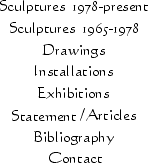| 
Contrasts of Concept and Form
Artweek, March 29, 1986
by Victoria Powers
Trudging through the seemingly endless flow of often poorly executed neo-expressionism has, of late, become both boring and depressing, but it makes an encounter with work such as Joseph Slusky's all the more gratifying. Here is an artist who clearly revels in the act of creating and consummates that act with skill. Slusky's development began with assemblage sculptures, made primarily from metal objects salvaged from junkyards and scrap heaps. Over the past two decades, his sources of material have remained largely unchanged, though the castoffs incorporate themselves into his sculptures so elegantly that a free-flowing energy stretches the possibilities of solid and void. Ultimately, the inevitable interpenetration, the sonorous balance, solidly affirms the figure in space.
Evident within the is body of work at Victor Fischer Galleries are influences of-or perhaps allusions to - the California Funk esthetic of William T. Wiley, Clayton Bailey and Robert Hudson and their antecedents. This speaks largely to a contemporary attitude that accepts all art history as available material, an attitude that accepts the vocabulary rather than the specific motivations or methodologies of movements.
Slusky's work, though its appearance is highly gestural has an underlying architectural pragmatism. Combining steel plates, rods and bars of various shapes, sizes and textures, each sculpture exploits crazily juxtaposed planes and a cacophony of brilliantly enameled colors, which somehow always pull together. And if, as the artist claims, he conceptualizes areas in shapes of colors rather than resolving them in terms of objects in space, these sculptures could be seen as fragmented, three-dimensional stained-glass windows in to another world.
Spider's Palace seems to be an architectural foray gone awry; a jungle gym for monstrous three-year-olds-or better yet, a cage for them, a polymorphous phalanx., within which the mind and eye can race over the garish colors and patterns and bounce from one plane to the next; where voids of ten echo the shape of the intrusive solid surrounding them. Xanadu, hardly an Arcadian delight, nostalgically recalls a Rube Goldberg phantasmagoria-a balancing act of sizable proportions where, if one element were misplaced, instantaneous chaos would result.
But to assume that all is mere fun and games here is to sadly misconstrue Slusky's intentions. These works, through their producer's complex process of creating self-referential objects that refuse to coalesce but must be dealt with and explored in accordance with the disparate conditions under which a form may ultimately be defined. The one common element, the thread that invisibly touches them all and allows them to occupy their space with such rational civility, is the underlying geometry and their cloisonné-like surfaced, malleable and slick. Matisse felt that his most successful works were those that were ultimately "condensations of sensations." Slusky's work fairly bursts with examples of this.
|

